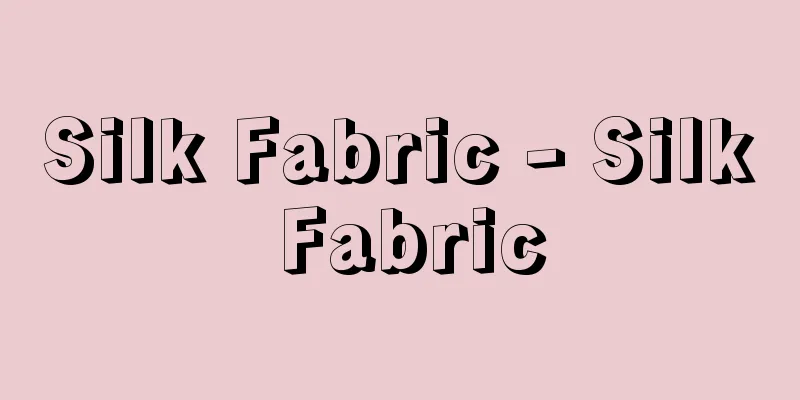Silk Fabric - Silk Fabric

|
A general term for textiles made from silk thread, dupioni (thread spun from a cocoon containing two or more silkworms), wild silk thread from tussah, wild wild silkworms, and Eri silkworms, and spun thread from spun silk and spun silk. These can be broadly categorized into raw silk fabrics (also simply called raw silk, raw fabrics, or piece-dyed fabrics), which are woven using raw silk as is and then refined and bleached, and degummed silk fabrics (also simply called degummed fabrics or pre-degummed fabrics), which are woven using raw silk after being degummed and bleached as thread. Silk is degummed because raw silk has sericin, a gelatin, that adheres to the surface of the fibers, making them uneven and lacking in luster, and this must be removed to expose the fibroin, which has the natural smooth feel and luster of silk. Therefore, scouring, bleaching, and removal either before or after weaving will change the properties of the fabric itself. A wide variety of silk fabrics are produced, depending on the quality of the thread, the twist of the thread, the weave, and the conditions of the place of origin, including wrinkled fabrics, lustrous fabrics, and thin, see-through fabrics. Representative fabrics include traditional fabrics such as nishiki, aya, ra, karaori, shusu, donsu, brocade, habutae, chirimen, rinzu, omeshi, meisen, and oshima, as well as Japanese fabrics, obi fabrics such as tsuzure nishiki and Hakata-ori, and wide-width Western fabrics such as brocade and taffeta. When weaving silk, the silk's properties are an issue, and because it has a high rate of stretch, the weaving front of the loom must be long, and even for high-rise looms, a very long loom was required, known as an ikkenbata loom. Especially during the Edo period, restrictions were placed on the wearing of silk, so production was generally concentrated in Nishijin, and in rural areas, looms were only made by each feudal domain to encourage domestic production, and as a result, the range of use of looms was limited. The domestic production of modern iron silk looms began when Tsuda Yonejiro worked to improve silk power looms during the construction of a weaving factory in the Hokuriku region, and finally in 1902 (Meiji 35) with the cooperation of Mizuto Yujiro, head of the Kanazawa Chamber of Commerce, he succeeded in putting the Tsuda-type power loom to practical use, contributing to the production of export habutae. In 1898 (Meiji 31), Saito Toichi of Tsuruoka, Yamagata Prefecture invented the Saito type power loom, which was manufactured and sold by Yoshida Ryosaku in Kanazawa and became widely used due to its efficiency and lower cost than the Tsuda type. Inspired by the manufacture of these power looms, various power looms of the Onishi, Kawasaki, Yoshioka, Oka, Shimizu, and Omote types were produced through imitation and partial improvements. Like cotton fabrics, silk fabrics come in wide and narrow widths. All silk fabrics for export are wide, with most measuring 91.4 centimeters (36 inches), while silk fabrics for the mainland are generally narrow, except for obi fabrics. The standard length for kimono fabric varies somewhat depending on the production area, but is about 36 centimeters (9.5 inches). In terms of length, silk fabrics for export are measured in units of 1 tan (generally 50 yards, or about 45.7 meters, or 30 yards depending on the variety), while silk fabrics for the mainland are measured in units of 1 tan (3 jo, or about 11.4 meters) or 1 tsubo (about 22.8 meters). When expressing the thickness of silk fabrics, the unit of momme (or mezuke) is used, which indicates the weight of a piece of silk with a width of 1 sun and a length of 60 shaku even after it has been degummed, in momme (1 momme = 3.75 grams). For example, a piece weighing 4 momme is called 4 momme. Overall, silk has the most refined and elegant luster of any fiber, and has been used for luxury fabrics since ancient times. Its advantages are that the fibers are very thin, long, and strong, so it can be easily woven into anything from thin fabrics such as twill and gauze to dense fabrics, and its low thermal conductivity makes it excellent at retaining heat. Furthermore, it is easy to dye, and can be dyed in bright hues. Its disadvantages are that it is easily embrittled by sunlight, and will turn brown if stored for a long time. It is also weak in alkaline solutions and will dissolve, so care must be taken when dyeing or washing. However, these drawbacks are also being improved through treatments such as resin processing. Silk is produced in the traditional areas of Nishijin in Kyoto and Hakata in Kyushu, but generally speaking, production areas are largely divided into raw silk and degummed silk. This is because the supply of raw materials from sericulture, and natural conditions such as water quality, water availability, and annual temperature and humidity differences have a large impact on textile production in each region. Raw silk is woven in the humid areas facing the Sea of Japan from Hokuriku to the Tohoku region, and is represented by habutae, crepe, and shiose in Fukui and Ishikawa prefectures. Degummed silk includes meisen, Kai silk, taffeta, and omeshi, and is produced in Yuki, Ashikaga, Kiryu, Isesaki, Chichibu, and Hachioji, which are spread across the foothills of the Kanto Plain. Other regions also produce distinctive textiles by inheriting weaving techniques that were introduced after the mid-modern period. The history of silk weaving began in China during the Neolithic Age. Along with sericulture and silk reeling, weaving technology had already reached a highly advanced stage during the Yin dynasty, with even patterned fabrics being woven. During the Han dynasty, warp brocade, which uses warp threads to create patterns, was woven, and silk weaving technology in ancient China reached its peak. Products were transported to the Western world via the Silk Road and sea routes, and their quality was praised in the Western world and the Roman Empire, where they were traded for the same weight as gold coins. However, due to the need to protect domestic products in China, silkworm eggs were only introduced to the West relatively slowly, around the middle of the 6th century, and silk production eventually began in the Middle East and the Mediterranean world. The center of silk textiles was Persia, and silk textile production flourished during the Sassanid Empire, which then traveled the Silk Road to China and then to Japan, where it was used to decorate brocades during the Asuka and Nara periods. In the Mediterranean world, silk textiles brought to the Roman Empire were successfully absorbed, and production spread to Italy, Spain, and southern France. The true form of silk textiles in the Middle Ages can be seen in the shrouds of Christian saints. Lyon in France flourished greatly under the protection and encouragement of Colbert, and built a world of traditional beauty in early modern Europe. Silk fragments brought to northern Kyushu in the early Yayoi period were excavated as iron products, and it is believed that silk had already been introduced from China and the Korean peninsula at this time, and that silk fabrics were already being produced in some areas. Then, in the Kofun period, the number of excavated pieces continued to increase, with tsugi brocade being excavated from the middle period and twill from the later period, and the production of high-quality fabrics flourished, and they were used for clothing and keiko. In the Asuka and Nara periods, they were mainly produced in western Japan as tax payment. Brocade, twill, and ramie were representative high-quality fabrics at the time, and silk and ashiginu were common silk fabrics, but because these were strongly promoted by the state under the Ritsuryo system, they eventually declined by the end of the ancient period, and only survived in the production of Oribe no Tsukasa and local kokuga. In the Middle Ages, a small amount of textiles were imported from the Song Dynasty, and domestic production continued the ancient traditions, resulting in the creation of specialty products such as Awa silk, Mino Hachijo silk, Hitachi silk, Kii Katori silk, and Iwami tsumugi silk. From the end of the Middle Ages to the beginning of the early modern period, production underwent a period of transition, with new weaving techniques introduced from China (Ming), and silk brocade, Chinese weaving, and damask silk were domestically produced. In particular, the silk twisting method was introduced, and a wrinkled fabric called crepe was produced, which gave birth to Kyoto crepe, and spread to various regions, giving rise to local industries such as Tango crepe, Gifu crepe, and Nagahama crepe. Nishijin was particularly central to the production of high-quality textiles, with textiles from other regions only playing a supporting role. However, as demand increased, Nishijin alone was no longer able to meet the demand, and from the mid-modern period onwards, craftsmen were invited from Nishijin, and feudal lords introduced the technology to encourage domestic production, and the technology spread to other regions, producing specialty products. In the Meiji period, the introduction of Western machinery technology led to the adoption of jacquard and batten devices, and modern facilities such as the Tomioka Silk Mill and Tsukiji Silk Mill supplied high-quality raw silk through machine reeling, which stimulated demand for both exports and domestic demand, and production continued to rise until World War II. Wide-width export habutae silk was particularly popular, and just before World War II, annual production reached approximately 640 million square yards. However, rayon was invented at the end of the 19th century, and was called rayon (artificial silk). It was cheaper than silk, so it gradually ate into the silk industry, and nylon production, which had been developed before the war, came to replace silk after the war and put pressure on silk production. In particular, it completely replaced silk in the field of women's socks. This trend did not seem to return to its former state, but the rise in living standards after the war led to a renewed appreciation of the gorgeous texture unique to silk fabrics, and furthermore, nostalgia for traditional Japanese clothing created a boom, resulting in the restoration of silk's status as a luxury fabric. After the war, the future prospects for sericulture were poor, so efforts were made to reduce the area planted with mulberry trees, leading to a decline in raw silk production and an inability to meet the gradually increasing demand for raw silk, and in 1967 (Showa 42) Japan finally fell from a producing and exporting country to an importing country. Reflecting this consumption trend, synthetic fibers with the luster and texture of silk were created, and synthetic silk is now used in the kimono industry. The quality of silk fabrics is stipulated in the Japanese Industrial Standards (L) and in the Silk Fabric Testing Method. When handling silk, it is important to be aware of the properties of the silk itself. When washing, wash at low temperature with neutral soap and rinse thoroughly in cold water. If soap remains, it will tangle with the fabric, causing a loss of luster and feel, and turning yellowish brown. It is susceptible to ultraviolet light, so dry in the shade. Some silk is treated with tin dichloride as a bulking agent, but this absorbs moisture well and, as the outside temperature rises, can cause stuffiness and make the fabric brittle. However, with the advancement of processing technology, resin processing is being used to prevent silk from turning yellowish brown, and to improve abrasion resistance and color fastness, which are disadvantages of silk, and improvements are being made to the previous difficulty of handling. [Kadoyama Yukihiro] "The History of the Development of Japanese Dyeing and Weaving" by Yukihiro Kadoyama (1967, Tabata Shoten)" ▽ "Learn Weaving" edited by Kyoto University of Art and Design (1999, Kadokawa Shoten)" ▽ "Encyclopedia of Silk and Cotton in the Edo Period" by Teijiro Yamawaki (2002, Yoshikawa Kobunkan) [Reference] | | | | | pongee| | | | |Chinese | | | | | |Silkworm | | | | | |Silk | | | | | | weaving| | | | | |Hakata | | | | | | | | |Source: Shogakukan Encyclopedia Nipponica About Encyclopedia Nipponica Information | Legend |
|
絹糸、あるいは玉糸(繭のなかに2匹以上のカイコが入ったものから糸を引いたもの)、柞蚕(さくさん)・天蚕(てんさん)・エリ蚕などの野蚕糸、紡ぎ糸・絹紡糸など紡績した糸を使って織物としたものの総称。これを大別すると、生糸をそのまま使い織り上げてから精練漂白する生絹(きぎぬ)織物(または単に生絹・生(き)織物・後染めともいう)と、生糸を糸のまま精練漂白したのち製織する練絹(ねりぎぬ)織物(または単に練織物・先練ともいう)とに分けられる。絹を練るのは、生糸のままでは、繊維の表面に膠質(こうしつ)のセリシンが付着して平滑でなく、光沢がないので、これを除去し、絹本来の手ざわりが滑らかで、光沢のあるフィブロインを露出させる必要がある。したがって、製織する前と後のいずれかで精練漂白し除去することは、織物自体の性質を変えてしまうことになる。 絹織物は、糸質、糸の撚(よ)り、織物組織、産地事情などにより、しわのある織物、光沢のある織物、地薄の透いてみえる織物など、多種類にわたる織物が生まれるが、代表的織物には、錦(にしき)・綾(あや)・羅(ら)・唐織(からおり)・繻子(しゅす)・緞子(どんす)・金銀襴(らん)・羽二重(はぶたえ)・縮緬(ちりめん)・綸子(りんず)・お召・銘仙・大島などの伝統的織物や和服地、綴錦(つづれにしき)・博多織(はかたおり)などの帯地、ブロケード、タフタなど広幅に織り出した洋服地などがある。 絹の製織には、絹の性能が問題になるが、伸展率が大きいので、織機の織前(おりまえ)を長くしなければならず、一間機(いっけんばた)とよばれるように高機(たかばた)にあっても、非常に長い機を使用する必要があった。とくに江戸時代には、絹の着用が制限されたので、一般には西陣に生産が集中し、地方では国産奨励のため各藩でつくられたくらいで、そのため織機も使用範囲が狭い。近代的鉄製絹織機の国産化は、津田米次郎(よねじろう)が北陸の機業場建設の過程において、絹用力織機の改良に努め、ようやく1902年(明治35)に金沢商業会議所会頭水登勇次郎の協力を得て、津田式動力織機の実用化に成功し、輸出羽二重の生産に寄与することになった。また1898年(明治31)には、山形県鶴岡(つるおか)の斎藤外市により斎外(さいと)式力織機が発明され、金沢市において吉田良作が製作販売するや、能率的で津田式より安価であることから、高い普及度をもつことになった。これらの力織機製作に刺激され、模倣と一部の改善により大西・川崎・吉岡・岡・清水・表などの各式の力織機が製作された。 絹織物の寸法は、綿織物と同じく広幅と小幅物がある。輸出向けはすべて広幅で、91.4センチメートル(36インチ)幅のものが多く、内地向けは帯地などの場合を除いて一般に小幅で、着尺地は産地事情により幾分異なるが、約36センチメートル(鯨尺9寸5分)を標準としている。また長さでは、輸出向けは1反(一般的には50ヤード、約45.7メートル、品種により30ヤード)で、内地向けは1反(鯨尺3丈、約11.4メートル)、または1匹(約22.8メートル)を単位としている。絹織物の厚薄を表すときに、匁付(もんめづけ)(あるいは目付ともいう)が使われるが、これは精練したのちも幅1寸、長さ60尺の重量を匁(1匁=3.75グラム)で示し、たとえば4匁であれば四匁付という。 絹の性能は、全般的にあらゆる繊維のうちでいちばん上品で温雅な光沢があり、古くから高級織物に用いられてきた。長所としては、非常に繊維が細くて長く、しかも強いので、地薄な羅や紗(しゃ)などの織物から組織の緻密(ちみつ)な織物まで、たやすく織ることができ、熱の伝導率が低いため保温性に富んでいることである。そのうえ、染色は容易であり、明るい色相に染めることができる。短所としては、日光によって脆化(ぜいか)しやすく、長く貯蔵しておくとき褐変することである。またアルカリ性に弱く、溶解するため、染色のときや洗濯には注意を要する。しかし、この欠点も樹脂加工などの処理法によって改善されつつある。 絹の生産地は、伝統的な京都市の西陣(にしじん)一帯や九州の博多などがあるが、一般的には、生絹織物と練絹織物により生産地域が大きく分かれている。これは、地域により、養蚕による原料供給、自然条件としての水質・水利・年間温湿度差の大小が、織物生産に大きく影響を与えているのである。生絹織物は、日本海に面する北陸から東北地方にかけての多湿地帯で織られ、福井県・石川県などの羽二重・縮緬・塩瀬で代表され、練絹織物には、銘仙・甲斐(かい)絹・タフタ・お召などがあり、関東平野の山裾(やますそ)一帯に広がる結城(ゆうき)・足利(あしかが)・桐生(きりゅう)・伊勢崎(いせさき)・秩父(ちちぶ)・八王子などで生産されている。ほかの地方でも、近世中期以後に伝えられた織物技術を受け継いで特徴ある織物を生産している。 絹織物の歴史は、新石器時代に入って中国で発生をみた。養蚕・製糸とともに、製織技術は、すでに殷(いん)代に高度の段階に達し、紋織物さえも織られている。これが漢代になると、経糸(たていと)を使って模様を表す経錦(たてにしき/けいきん)が製織されるに至り、古代中国の絹織技術は最高に達した。製品は、シルク・ロードと海路を通して西方世界に運ばれ、西方世界・ローマ帝国において、その品質は賞賛され、金貨と同じ重量で取引されたといわれる。しかし中国の国産保護のため、西方へ蚕種の伝わったのは比較的遅く、6世紀中ごろで、やがて中近東から地中海世界にかけて絹生産が開始されるに至った。その中心はペルシアであり、とくにササン朝ペルシアの時代には、絹織物の生産が盛んになり、その流れは、今度は反対にシルク・ロードを通って中国にもたらされ、そして日本に達し、飛鳥(あすか)・奈良時代の錦綾(にしきあや/きんき)を飾った。地中海世界においては、ローマ帝国にもたらされた絹織物はみごとに消化され、イタリア、スペイン、そして南フランスにまで生産が拡大されることになる。中世の絹織物の実体は、キリスト聖者の聖骸布(せいがいふ)にみることができる。そしてフランスのリヨンはコルベールの保護奨励によって非常に栄え、近世のヨーロッパにおける伝統美の世界を築き上げた。 日本へは弥生(やよい)式時代の前期に北部九州へもたらされた絹断片が、鉄製品に残存して出土し、すでにこのころには中国、朝鮮半島より伝来しており、一部に絹織物の生産が行われたものとみられる。そして古墳時代に入ると、さらに出土は増加の一途をたどり、中期から経錦、後期から綾の出土がみられ、高級織物の生産が盛んとなり、衣料・桂甲(けいこう)に使用された。飛鳥・奈良時代には、税制の調(ちょう)として、おもに西日本で生産された。錦・綾・羅は当時の代表的高級織物であり、絹・絁(あしぎぬ)が一般的な絹織物であるが、これらは律令(りつりょう)制下に国家が強力的に推し進めた生産であるため、やがて古代末期には衰退するに至り、織部司(おりべのつかさ)や地方国衙(こくが)生産においてわずかに命脈を保ったにすぎない。中世にはわずかではあるが、宋(そう)の織物が輸入され、また国内生産も古代の伝統を引き継いで、阿波(あわ)絹・美濃(みの)八丈・常陸(ひたち)絹・紀伊かとり・石見紬(いわみつむぎ)などの特産品も生まれた。中世末から近世初頭にかけて生産の転換期を迎え、中国(明(みん))から新しい織物技術が伝来し、綸子・唐織・緞子などが国産化された。とくに絹の撚糸(ねんし)法が伝わり、縮緬という皺(しぼ)のある織物がつくられ、京都縮緬を生んでから、各地へ伝わり、丹後(たんご)縮緬・岐阜縮緬・長浜縮緬などの地場産業を生むこととなった。とくに高級織物の生産は西陣が中心で、各地の織物はその補助的な役割を果たすにすぎなかったが、需要の増大とともに西陣だけではまかないきれず、近世中期以後は、西陣から技術者を招聘(しょうへい)したり、藩主が国産奨励のため、技術を導入するなど、各地へ伝播(でんぱ)していき、特産品をつくっていった。 明治時代になると、西欧機械技術の導入により、ジャカード、バッタン装置などが取り入れられ、また近代的な富岡製糸所・築地(つきじ)製糸場などによって、機械製糸が良質の生糸を供給したが、それによって輸出・内需ともに需要をおこす誘因ともなり、第二次世界大戦に至るまで生産額は上昇の一途をたどった。とくに広幅輸出羽二重が盛んに生産され、第二次世界大戦直前には年産額約6億4000万平方ヤードに達した。しかし19世紀末にはレーヨンが発明され、人絹(人造絹糸)とよばれて、絹に比べて安価なことから、しだいに絹の分野を蚕食し、また戦前から開発されていたナイロン生産は、戦後、絹にとってかわって進出し、絹生産を圧迫することになった。とくに婦人用靴下の分野では、まったく絹を駆逐することになった。この傾向はもとの状態へ復帰しないようにみられたが、戦後における生活水準の向上は、絹織物独特の華麗な風合いが再認識され、さらに和服への懐古趣味は一つのブームを生み、高級織物としての地位を回復する結果となった。戦後の養蚕は、将来の見通しが十分でなかったので、クワの作付面積の縮小転換が図られ、生糸生産高は減少し、漸増する生糸需要量をまかなうことができず、1967年(昭和42)ついに生産輸出国から輸入国に転落した。このような消費傾向を反映して、絹の光沢と風合いをもつ合成繊維が生まれ、着物の分野に合成絹として進出している。 絹織物の品質については、日本工業規格(L)のなかに定められており、絹織物試験法に規定されている。絹の取扱い方法で注意を要するのは、絹自体の性質をよく知っておくことである。洗濯では、低温で中性せっけんを使って洗い、冷水でよくすすぐ。せっけん分が残ると生地に絡み、光沢、手ざわりが悪くなり、黄褐変を呈する。紫外線に侵されやすいため、日陰干しにする。絹には増量剤として第一塩化スズを施したものがあるが、これは湿気をよく吸収し、さらに外気の温度の上昇につれて、いわゆるむれを生じ、質をもろくすることがある。しかしながら加工技術の進歩から、樹脂加工によって、絹の欠点である黄褐変防止や、耐摩耗性、染色堅牢(けんろう)度などの向上が図られ、従来の取扱いにくさからの改善がなされつつある。 [角山幸洋] 『角山幸洋著『日本染織発達史』(1967・田畑書店)』▽『京都造形芸術大学編『織を学ぶ』(1999・角川書店)』▽『山脇悌二郎著『事典絹と木綿の江戸時代』(2002・吉川弘文館)』 [参照項目] | | | | | | | | | | | | | | | | | | | | | | | | | | | | | | | | | | | | | | | | | | |出典 小学館 日本大百科全書(ニッポニカ)日本大百科全書(ニッポニカ)について 情報 | 凡例 |
Recommend
Species (English spelling)
In Taoism in the Six Dynasties, Sui and Tang dynas...
Imperial Commissioner
…In China, during the Qing Dynasty, a specially e...
Earl Zemetier - Earl Zemetier
…3-year course. École nationale supérieure d'...
Chohan Kumasaka
Date of birth and death unknown. A great thief fr...
Eucomis comosa (English spelling) Eucomis comosa
…[Tora Saburo Kawabata]. … *Some of the terminolo...
《Crown of Honor》
…The usual format is for the honor guard to salut...
Yin - Yin
〘Noun〙 ("In" is the Chinese pronunciatio...
Rubeshibe [town] - Rubeshibe
A former town in Tokoro County, eastern Hokkaido. ...
Edge metal fittings
...The metal fittings on the corners and center o...
Independent Review - DOKURITSHYORON
A personal magazine published by Yamaji Aizan. Fir...
Inland water fisheries
Fishing conducted in inland waters such as lakes,...
Lynx (Lynx) - Lynx (English spelling)
A medium-sized carnivorous mammal of the Felidae f...
Waikato River (English spelling)
Located on New Zealand's North Island, this is...
Shu-Sin (English spelling)
...Later, his son (or brother) Ur-Nammu gained in...
Habeas corpus
A type of British court warrant. It developed arou...









